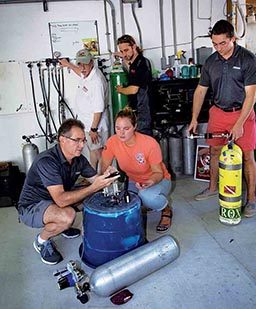This winter DAN® risk-mitigation team members took up residence in Key Largo, Florida. Led by Francois Burman, the team was tasked with testing the DAN Hazard Identification and Risk Assessment (HIRA) program in one of the world’s most popular diving destinations. Every year thousands of divers explore the area’s shipwrecks and national marine sanctuaries as well as the nation’s only living barrier reef. The location is flanked by three major metropolitan areas as well as Everglades National Park and a litany of wildlife conservations, creating an undeniable attraction for divers and families alike. The combination of beautiful conditions, sheer numbers of divers and the proactive and safety-conscious attitude of the operators in Key Largo made it the ideal destination to test a program designed to raise the standard of dive safety in the industry.
The HIRA program is a reinvention of a tried and tested industry-safety methodology used in the health-care, manufacturing and hyperbarics fields. The program trains dive operators and professionals to objectively assess their businesses, charters, teaching methodologies and facility operations. Every aspect of a business is included, whether the participant is an operator with a few dozen employees or an independent charter or instructor. From customer health and safety to workplace compliance and liability management, the HIRA program guides professionals through the hazards that real dive operations face, including identification of which hazards are directly applicable to them and how to best mitigate them for the safety of themselves and their customers.
The program is extensive, and its details are nuanced, but the concept is not. By providing this program to all dive professionals who are willing to participate and wanting to improve the quality of their operation, DAN aims to create a new standard of safety that divers can expect no matter where they dive. This program will soon be officially open to all DAN Professional members.

For more than a week, DAN risk-mitigation team members met with nearly two dozen major dive operators in the greater Key Largo area to test the new HIRA program, which uses not only injury and incident data from the extensive DAN databases, but also data from a long list of other industries and sources such the Centers for Disease Control and Prevention (CDC) and the Occupational Safety and Health Administration (OSHA). All the data in the world is useless without direction and understanding, however, and that information is what these operators provided. Formed using the industry experience of those on the team as well as outside consultants and advisors, the HIRA program still required input from those working in the busiest parts of the dive industry to streamline the process and make it more effective and applicable to real-world dive operations.
The DAN team quickly implemented suggestions such as minimizing paperwork, fine-tuning an understanding that the program is voluntary and that assessments are entirely self-directed (rather than externally audited), and creating an easy-to-use eLearning platform. Once operators understood that the HIRA program is a tool for them to apply on their own, to use in assessing their own risks rather than having an external auditor do it, they began to rapidly and enthusiastically embrace it. Even the most experienced operators learned something they could directly apply to their business, even if they had only participated in a partial HIRA assessment.
Whether improvements to fill-station safety, new standard operating procedures for employee health and liability maintenance or a refresher on right of refusal and the laws regarding safe charter and training operations, every business that took the opportunity to engage came away with something worth their time. Of note were the suggested improvements from the largest operations. After running through a guided self-assessment, operations that had previously hired industry experts to design their operational flow discovered significant hazards, potential customer safety improvements and liability mitigation steps.
When the full HIRA program becomes available to the industry, it will look a lot like what the operators in the Florida Keys saw, but it will include the recommendations and wisdom of business owners with 40 and 50 years of experience as well as improvements that come with multiple full-scale, real-world trials. This summer, watch for businesses in your area that have taken the initiative to improve themselves and protect you. You’ll be able to locate these businesses on DAN.org, meet them at DAN Diver Day events and recognize them by the HIRA program certificate on their wall.
No matter how prepared or dedicated the staff are, every facility has room for improvement, and putting in the time and work required to thoroughly assess a business and improve the safety of customers is something that deserves recognition. Support your local dive shop however you can, and help them improve their business by recommending that they participate in the HIRA program. DAN is here to help every step of the way.
| © Alert Diver — Q2 2018 |